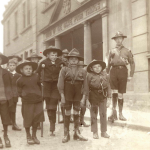1976
In this short film Maggie Davis describes how she became disabled and how she and her husband Ken resisted being put in an institution, which appeared to be the only option in 70s Britain.
 Chiswick House, London
Chiswick House, London
 Maison Dieu, Faversham
Maison Dieu, Faversham
 Liverpool School for the Indigent Blind, Liverpool
Liverpool School for the Indigent Blind, Liverpool
 Langdon Down Museum of Learning Disability, Teddington
Langdon Down Museum of Learning Disability, Teddington
 The Royal School for Deaf Children, Margate
The Royal School for Deaf Children, Margate
 Guild of the Brave Poor Things, Bristol
Guild of the Brave Poor Things, Bristol
 St Saviour’s Deaf Church, Acton
St Saviour’s Deaf Church, Acton
 Grove Road Housing Scheme, Sutton-in-Ashfield
Grove Road Housing Scheme, Sutton-in-Ashfield
In this short film Maggie Davis describes how she became disabled and how she and her husband Ken resisted being put in an institution, which appeared to be the only option in 70s Britain.
The idea of Independent Living spread. In 1981, a Leonard Cheshire Home, Le Court, started to explore the idea of helping residents to live independently, and created houses for which they became the landlord. Frances Hopwood was among those who eventually chose to move after 17 years at Le Court. She recorded an oral history, in the late 1990s explaining the process and what shaped her decision.
There is a major breakthrough when Reverend Short contacts Ken with an offer of suitable land to build on, providing there is planning permission and a housing association willing to take it on. There are complications: the very idea of people wanting to set up home independently in the community with Ken and Maggie’s impairments was so revolutionary that no official category of housing provision actually existed to encompass it. This factor caused endless difficulty in the initial stages of obtaining planning consent.
Maggie returns to England after 18 months nursing in Beirut. She is engaged to a doctor but has returned home for a visit to reflect while doing some private nursing in London.
She has been experiencing neck pains following a car accident, but doesn’t think anything of it. One morning, having returned to London and nursing, Maggie is found unconscious in the hotel room of a patient she was nursing. She becomes paralysed and is admitted to Stoke Mandeville hospital and then the hostel as she does not wish to return home or go into one of the Cheshire or other homes.
Vic Finkelstein came to the UK as a refugee in 1968 after anti-apartheid activism in South Africa. He joined and became a leading light in the nascent disability movement in the UK.
The Disability Discrimination Act is passed in 1995, the culmination of much of the activism which took place in the 1970s. The Act put into law steps to reduce state and business discrimination against disabled people. It has since been superseded by the 2010 Equality Act.
Paul Hunt writes to the Guardian on 20th September 1972 to complain that disabled people are ‘isolated in unsuitable institutions’ where their ‘views are ignored and they are subject to authoritarian and often cruel regimes’. He says he is planning a ‘consumer group’ to give disabled people a voice.
We are currently working with the V&A London and RIBA to catalogue and safeguard Maggie’s wonderful archive material. We are planning an exhibition at the V&A later in 2018 to explore the ways deaf and disabled people have influenced building design. Ken and Maggie’s story will form a key part of this exhibition.
Maggie meets Ken, who is an outpatient at Stoke Mandeville – along with others who are residents or outpatients, they start discussing the possibility of independent living outside institutions. Ken approaches other Housing Association schemes, but none are deemed suitable for the group’s specific needs.
Meanwhile, the Union of the Physically Impaired Against Segregation (UPIAS) was founded by Paul Hunt – Vic Finkelstein and Ken and Maggie Davis are key members.